Juniper’s Campus Fabric:
Juniper’s Campus Fabric leverages EVPN VXLAN as the underlying technology for small, mid, and large Enterprise deployments. Campus Fabric is built and managed using Mist’s Wired Assurance Cloud-ready AI-driven framework. For additional information on Juniper’s Campus Fabric, please leverage the following Wired Assurance Datasheet and Video Overview and Build demos:
One of the most popular small to mid-size Enterprise networking architectures is Collapsed Core. In this model, customers deploy up to 2 Ethernet switching platforms that are interconnected using technologies such as VRRP, HSRP and MC-LAG. The endpoint devices: laptops, Access Points, printers, and IOT devices plug into the Access layer using various Ethernet speeds: 100M, 1G, 2.5G, 10G. The Access Layer switching platforms are multihomed to each collapsed core Ethernet switch in the Core of the network. The following represents the traditional collapsed core deployment model:
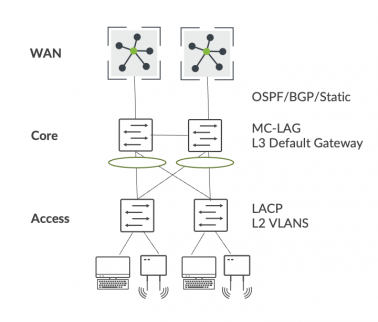
Figure 1: Collapsed Core Topology
The Collapsed Core deployment model presents the following challenges:
- Proprietary MC-LAG technology that requires a homogeneous vendor approach
- Lack of horizontal scale; up to 2 Core devices in a single topology
- Lack of native traffic isolation capabilities in the Core
- Not all implementations support active-active load balancing to the Access layer
Juniper’s EVPN Multi-Homing addresses the Collapsed Core model of the multi-homed Access layer while supporting the following characteristics:
Standards based EVPN-VXLAN framework
- Horizontal scale supporting up to 4 Core devices
- Traffic isolation capabilities native to EVPN-VXLAN
- Native active-active load-balancing to the Access layer using ESI-LAG
- Standard LACP at the Access layer
- Mitigate the need for Spanning Tree between the Core and Access layer
- Managed using Mist Wired Assurance
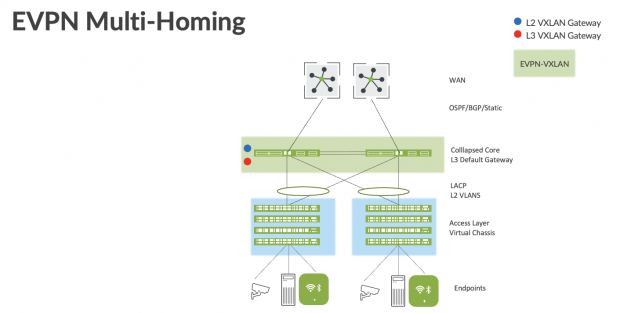
Figure 2: EVPN Multi-Homing
Juniper Platform support for EVPN Multi-homing:
- Core:
- EX9200 | QFX5120 | EX4650 | EX4400-24X
- Access:
- 3rd Party using LACP|Juniper Virtual Chassis or standalone EX switches
When to choose EVPN Multi-Homing:
- Retain investment in the Access Layer
- Legacy hardware supporting Collapsed Core must be refreshed
- Deployment that may need to scale past 2 devices in the Core
- Leverage existing Access layer without introducing new hardware/software models
- Native active-active load-balancing to the Access layer using ESI-LAG
- Managed using Cloud based AI Driven Enterprise framework
- Mitigate the need for Spanning Tree between Core and Access layer
- Standards based EVPN-VXLAN in the Core
Enterprise networks that scale past the Collapsed Core model typically deploy a traditional 3 Stage Architecture of Access, Distribution, and Core. In this case, the Core is providing L2/L3 connectivity to all users, printers, AP, etc. The Core interconnects with Dual WAN routers using standards based OSPF or BGP technologies.
Most of the ethernet switching hardware costs of an Enterprise Network exists at the Access Layer where endpoint terminate. The endpoint devices: laptops, Access Points, printers, and IOT devices plug into the Access layer using various Ethernet speeds: 100M, 1G, 2.5G, 10G. Therefore, customers must leverage the capabilities of these devices for longer term cycles than at other layers of the network.
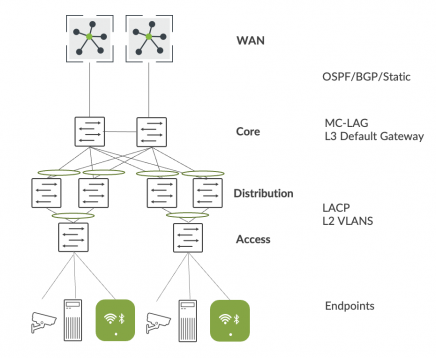
Figure 3: 3-Stage Core Distribution Access Network
This deployment model introduces the following challenges:
- Proprietary Core MC-LAG technology that requires a homogeneous vendor approach
- Difficult to scale the Core layer past 2 devices
- Lack of native traffic isolation capabilities anywhere in this network
- Spanning Tree is required between the Distribution and Access and potentially between the Core and Distribution layers creating sub-optimal use of links
- Careful planning required if L3 boundary moves between Core and Distribution
- VLAN extensibility requires plumbing of VLANs across all links between Access switches.
Juniper’s Campus Fabric Core-Distribution architecture addresses the physical layout of a 3-Stage Core Distribution Access model of while supporting the following characteristics:
- Retain investment in the Access layer
- Standards based EVPN-VXLAN framework
- Horizontal scale at the Core and Distribution layers supporting an IP Clos architecture
- Traffic isolation capabilities native to EVPN-VXLAN
- Native active-active load-balancing to the Access layer using ESI-LAG
- Standard LACP at the Access layer
- Mitigate the need for Spanning Tree between all layers
- Managed using Mist Wired Assurance supporting the following modes:
- Centrally Routed Bridged
- Targeting North-South traffic patterns with the L3 boundary/Default gateway shared between all Core devices
- Edge Routed Bridged
- Targeting East-West traffic patterns and IP Multicast with the L3 boundary/Default gateway shared between all Distribution devices
- Smaller blast radius
- Centrally Routed Bridged
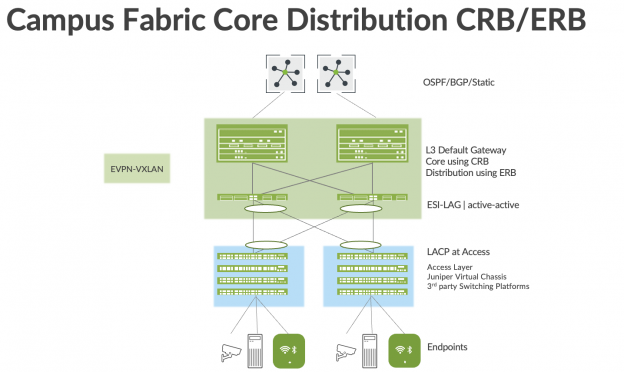
Figure 4: Campus Fabric Core-Distribution CRB/ERB
Juniper Platform support for Campus Fabric Core Distribution (CRB/ERB):
- Core:
- EX9200|QFX5120|EX4650|EX4400-24X|QFX5130|QFX5170
- Distribution:
- QFX5120|EX4650|EX4400-24X|QFX5130|QFX5170
- Access:
- 3rd Party using LACP|Juniper Virtual Chassis or standalone EX switches
When to choose Campus Fabric Core-Distribution
- Retain investment in the Access Layer while leveraging existing LACP technology
- Retain investment in Juniper Core and Distribution layers
- IP Clos architecture between Core and Distribution built on standards EVPN-VXLAN
- Active-active load-balancing at all layers in this model
- ECMP between the Core and Distribution
- ESI-LAG towards Access layer
- Managed using Cloud based AI Driven Enterprise framework
- Mitigate the need for Spanning Tree between all layers
Enterprise networks are undergoing massive transitions to accommodate the growing demand for cloud-ready, scalable, and efficient networks, and the plethora of IoT (Internet of Things) and mobile devices. As the number of devices grows, so does network complexity with an ever-greater need for scalability, segmentation, and security. To meet these challenges, Enterprises need a network with Automation and AI (Artificial Intelligence) for operational simplification. IP Clos networks provide increased scalability and segmentation using a well-understood standards-based approach EVPN-VXLAN with GBP (Group Based Policy).
Micro-segmentation challenges with today’s Enterprise architectures:
- Policy or ACL sprawl can overwhelm most departments based on security requirements
- Lack of standards in addressing Intra VLAN isolation requirements particularly when deploying IOT devices
- Lack of scale across an Enterprise network and beyond
- Lack of cohesive Micro-segmentation Policy management
Juniper’s Campus Fabric IP Clos architecture address Micro-segmentation requirements as well as the following characteristics:
- Micro-segmentation at the Access layer using standards-based Group Based Policy
- Integration with 3rd party NAC/Radius deployments
- Standards based EVPN-VXLAN framework across all layers
- Flexibility in scale supporting 3-Stage and 5-Stage IP Clos deployments
- Traffic isolation capabilities native to EVPN-VXLAN
- Native active-active load-balancing within Campus Fabric utilizing ECMP
- Optimized for IP Multicast
- Fast convergence between all layers using fine-tuned BFD
- Use of an optional Services Block for customers who wish to deploy a Lean Core
- Managed using Cloud based AI Driven Enterprise framework
- Mitigate the need for Spanning Tree between all layers
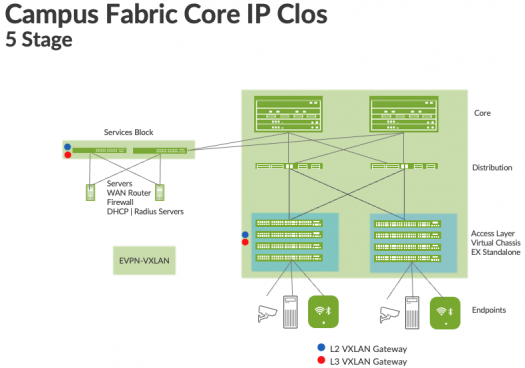
Figure 5: Campus Fabric Core-Distribution CRB/ERB
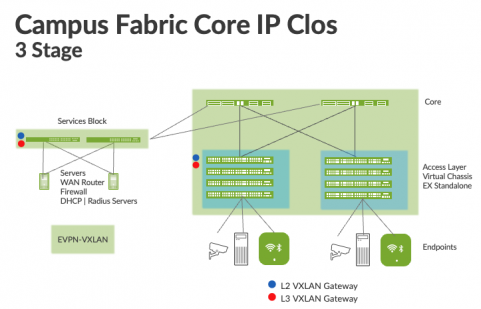
Figure 6: Campus Fabric Core-Distribution CRB/ERB
Juniper Platform support for Campus Fabric IP Clos:
- Core:
- EX9200|QFX5120|EX4650|EX4400-24X|QFX5130|QFX5170|QFX10k
- Distribution:
- QFX5120|EX4650|EX4400-24X|QFX5130|QFX5170
- Access:
- EX4100|EX4300-MP|EX4400
- Services Block:
- QFX5120|EX4650|EX4400-24X|EX4400|QFX5130|QFX5170|EX9200|QFX10k
When to choose Campus Fabric IP Clos
- Micro-segmentation at the Access layer using standards-based Group Based Policy
- Standards based EVPN-VXLAN framework across all layers
- Flexibility in scale supporting 3-Stage and 5-Stage IP Clos deployments
- Traffic isolation capabilities native to EVPN-VXLAN
- Native active-active load-balancing within Campus Fabric utilizing ECMP
- Optimized for IP Multicast
- Managed using Cloud based AI Driven Enterprise framework
- Mitigate the need for Spanning Tree between all layers